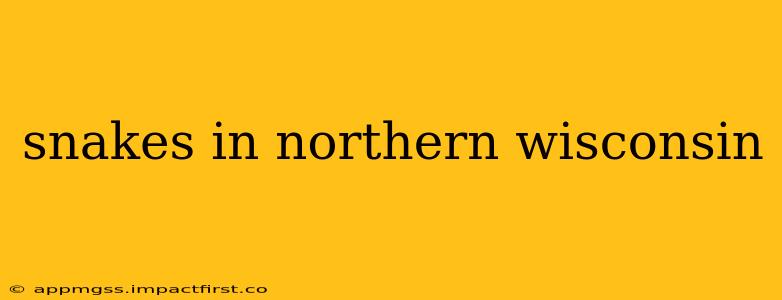Northern Wisconsin, with its diverse landscapes ranging from dense forests to sparkling lakes, provides a habitat for a variety of snake species. While some may evoke fear, understanding these reptiles is crucial for safe coexistence. This guide explores the common snakes found in the region, their characteristics, and how to interact with them responsibly.
What types of snakes live in Northern Wisconsin?
Northern Wisconsin is home to several non-venomous snake species. The most commonly encountered include:
-
Garter Snakes (Thamnophis sirtalis): These are arguably the most prevalent snakes in the region, exhibiting variations in color and pattern. They are slender, often with three lengthwise stripes, and are known for their docile nature.
-
Northern Water Snakes (Nerodia sipedon): These semi-aquatic snakes are often mistaken for venomous cottonmouths due to their similar coloration (often dark brown or black with dark crossbands). However, they possess a much more rounded head and are harmless to humans. They're frequently found near water bodies.
-
Smooth Green Snakes (Opheodrys vernalis): These slender snakes are bright green, often found in grassy meadows and fields. They are shy and quick to flee when disturbed.
-
Red-bellied Snakes (Storeria occipitomaculata): These small, secretive snakes are mostly dark brown or black with a characteristic reddish belly. They are rarely seen as they prefer to live under rocks, logs, and leaf litter.
Are there venomous snakes in Northern Wisconsin?
While the vast majority of snakes in Northern Wisconsin are harmless, the Massasauga Rattlesnake (Sistrurus catenatus) is the only venomous species found in the region. These snakes are relatively rare and prefer wetland habitats. They are shy and will generally avoid human contact, but their bite is dangerous and requires immediate medical attention.
How to identify a Massasauga Rattlesnake?
Identifying a Massasauga is crucial for safety. Key features include:
- Rattles: The presence of a rattle at the end of the tail is the most distinctive feature.
- Heavier Body: They have a more robust body compared to other non-venomous snakes.
- Triangular Head: Their head is broader and triangular in shape.
- Coloration: They typically have a pattern of dark brown or black crossbands on a lighter background.
What should I do if I see a snake in Northern Wisconsin?
The best approach is to observe the snake from a safe distance and leave it undisturbed. Most snakes are beneficial to the ecosystem, controlling rodent populations. Never attempt to handle a snake unless you are a trained herpetologist. If you encounter a rattlesnake, slowly back away and give it ample space.
What to do if bitten by a snake?
If bitten by a snake, seek immediate medical attention. Try to remember the snake's appearance (take a photo if possible, but prioritize your safety) to aid in diagnosis and treatment. Remain calm and avoid strenuous activity.
Are snakes dangerous to pets?
While most snakes pose little threat to larger pets, some, particularly the Massasauga Rattlesnake, can inflict a dangerous bite. Keep pets on a leash, especially near potential snake habitats.
Are there any programs to learn more about snakes in Northern Wisconsin?
Many local nature centers and conservation organizations offer educational programs and workshops about local wildlife, including snakes. Check with your local DNR office or natural history museums for information on such programs.
This comprehensive guide offers a starting point for understanding the snakes inhabiting Northern Wisconsin. Remember, responsible observation and respect for these creatures contribute to a healthy ecosystem for both wildlife and humans. Always prioritize safety and seek professional help when necessary.
